Five Elements theory

Five Phases theory
Five Phases (五行, pinyin: wu xÃng), sometimes also translated as the “Five Elements”  theory, presumes that all phenomena of the universe and nature can be broken down into five elemental qualities – represented by wood (木, pinyin: mù), fire (ç«pinyin: huÇ’), earth (土, pinyin: tÇ”), metal (金, pinyin: jÄ«n), and water (æ°´, pinyin: shuÇ).  In this way, lines of correspondence can be drawn:
| Phenomenon | Wood | Fire | Earth | Metal | Water |
|---|---|---|---|---|---|
| Direction | east | south | center | west | north |
| Color | green/blue | red | yellow | white | black |
| Climate | wind | heat | damp | dryness | cold |
| Taste | sour | bitter | sweet | acrid | salty |
| Zang Organ | Liver | Heart | Spleen | Lung | Kidney |
| Fu Organ | Gallbladder | Small Intestine | Stomach | Large Intestine | Bladder |
| Sense organ | eye | tongue | mouth | nose | ears |
| Facial part | above bridge of nose | between eyes, lower part | bridge of nose | between eyes, middle part | cheeks (below cheekbone) |
| Eye part | iris | inner/outer corner of the eye | upper and lower lid | sclera | pupil |
 Â
Strict rules are identified to apply to the relationships between the Five Phases in terms of sequence, of acting on each other, of counteraction etc.  All these aspects of Five Phases theory constitute the basis of the zà ng-fǔ concept, and thus have great influence regarding the TCM model of the body.  Five Phase theory is also applied in diagnosis and therapy.
Correspondences between the body and the universe have historically not only been seen in terms of the Five Elements, but also of the “Great Numbers” (大數, pinyin: dà shÅ«) For example, the number of acu-points has at times been seen to be 365, in correspondence with the number of days in a year; and the number of main meridians – 12 – has been seen in correspondence with the number of rivers flowing through the ancient Chinese empire.
Five Element Relationships
It was observed over the years that the Five Elements relate to each other in different ways.
- Sheng Cycle (Generating Sequence)
- Ko Cycle (Controlling Sequence)
- Destructive Cycle (Overacting Sequence)
- Anti Ko Cycle (Insulting Sequence)
The Generating Sequence or Mother-Child Relationship
As in the cycle of the seasons, each element generates another, i.e., one element is the “mother” of the next.
| Wood (Liver) creates Fire (Heart) | Wood is the Mother of Fire | Liver is the Mother of the Heart |
| Fire (Heart) creates Earth (Spleen) | Fire is the Mother of Earth | Â |
| Earth (Spleen) creates Metal (Lungs) | Earth is the Mother of Metal | Â |
| Metal creates Water | Metal is the Mother of Water | Â |
| Water creates Wood. | Water is the Mother of Wood | Â |
Naturally, therefore, each element is generated by another: Fire is the child of Wood, Earth is the child of Fire, etc. In nature, we see this in the seasonal changes: Winter transforms into Spring, Spring changes into Summer.
Controlling Sequence or Father-Child relationship Each element is said to control, check, or regulate another.
- Wood controls Earth
- Fire controls Metal
- Earth controls Water
- Metal controls Wood
- Water controls Fire
Each element is of course then controlled by another.
- Earth is controlled by Wood
- Wood is controlled by Metal, etc.
This cycle ensures that a balance is maintained between elements.
The “father-child” symbology relates to traditional family roles, where the father was the patriarchal head of the household. The mother, by comparison, is seen as the creative and nurturing force.
Overacting Sequence
This is the same as the Ko cycle, but in this sequence, one Element is said to “over-control” or “destroy” another, causing the controlled element to become Deficient. This happens when balance breaks down so that one element becomes excessive in relationship to another.
E.g. An excess of Wood energy will over-control Earth, causing Earth to become Deficient.
Insulting Sequence
This cycle is the reverse of the Ko cycle or controlling sequence. In the Insulting Sequence, the element that should BE controlled becomes imbalanced and excessive, and controls the element that normally controls it.
Example: Instead of Metal controlling Wood, if Wood becomes excessive, it can “insult” Metal, causing it to become imbalanced. This is akin to the child rebelling and insulting or trying to discipline its father.
Four Possible Pathologies
Element in Excess overacts on another (Overacting sequence)
Element in Deficiency insulted by another (Insulting sequence)
Element in Excess drains from Mother (pathological Sheng cycle)
Element in Deficiency fails to nourish Child (pathological Sheng cycle)
Five Element Aggressive Energy Treatment
This is a Five Element treatment used for clearing a patient of aggressive energy. It is very similar to the TCM treatment sometimes called the “Shen Cycle” or “Shen Circle”. Half inch (1/2″) needles are inserted just barely under the skin, from top to bottom and right to left, usually inserting BL-15 as the last point.
The points in this treatment:
- BL-13
Lung Shu - BL-14
Pericardium Shu - BL-15
Heart Shu - BL-18
Liver Shu - BL-20
Spleen Shu - BL-23
Kidney Shu
Needles are left in the patient until the redness that appears around the points is gone. A test point can be added to this treatment to gauge the redness appearing at specific points in the treatment.

